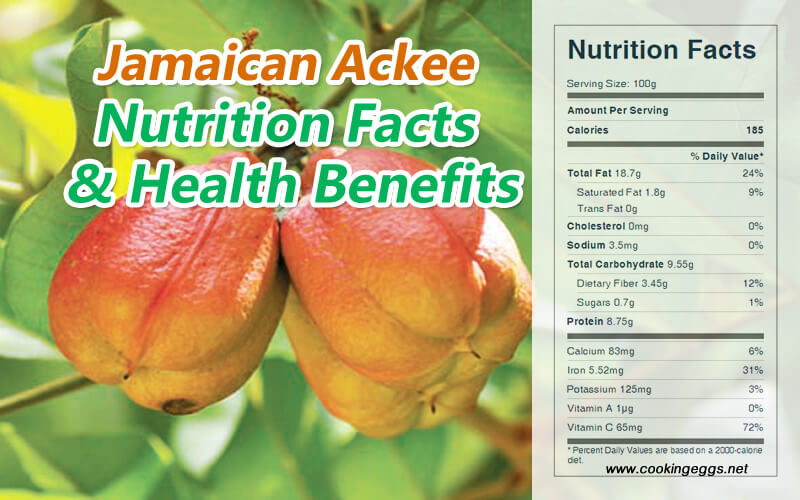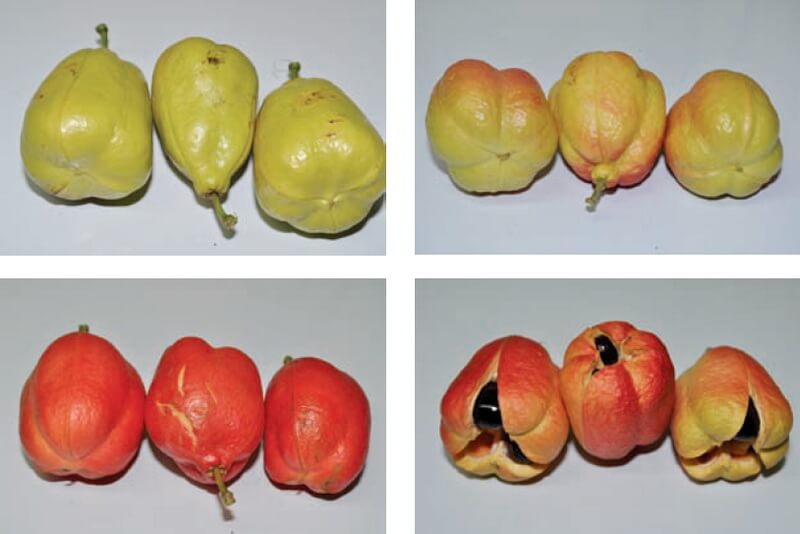Jamaican Ackee Nutrition Facts & Health Benefits
Ackee fruit is also called ankye, achee, akee, ackee apple, ayee, or vegetable brain. It is a tropical fruit that belongs to the family Sapindaceae and is a relative of the litchi (lychee) and the longan.
Ackee's scientific name is Blighia sapida, and it is native to tropical West Africa. It is a major feature of various Caribbean cuisines and is widely cultivated in tropical and subtropical areas around the world. Its fruit is pear-shaped, bright red to yellow-orange, and when ripe, splits open to reveal three large, shiny black seeds, surrounded by soft, creamy or spongy, white to yellow flesh. The soft, edible arils are delicate in flavor and taste and look similar to scrambled eggs.
It is one of the national dishes and is considered one of the national symbols in Jamaica. Underripe fruits are dangerously poisonous and consumption has resulted in fatalities. Mature arils are the only parts of the fruit that can be consumed, and they need to naturally ripen and split open before they are deemed safe for eating. When an ackee is ripe, it turns red and splits open, exposing the seeds inside and the fleshy, delicately flavored aril. When raw, the arils have a subtly sweet and tannic flavor reminiscent of avocado and almonds. When the arils are cooked, they develop a soft and delicate nature with a rich, nutty, and buttery flavor. It’s often eaten with cod fish. Sautéed over a hot stove with butter, onion, and sweet peppers, it can make a tasty dish.

Nutritional Value of Ackee Fruit
Ackee fruits are an excellent source of vitamin C, an antioxidant that strengthens the immune system, boosts collagen production within the skin, and reduces inflammation. The fruits are also a good source of fiber to regulate digestion and contain iron, calcium, and some vitamin A. Unripe Ackee fruits contain hypoglycin A and B, which are toxins that can cause Jamaican vomiting sickness and could be potentially fatal if ingested in large quantities.
Ackee contains a moderate amount of carbohydrates, protein, and fat, providing about 55% of the dry weight of the arils as composed of fatty acids—linoleic, palmitic, and stearic acids. Ackee is high in nutrients, vitamins, and minerals. Consuming 100 grams of ackee offers 18.7 g of fat, 65 mg of vitamin C, 240 mg of sodium, 83 mg of calcium, 1 mg of zinc, 5.52 mg of iron, 3.45 g of dietary fiber, 3.74 mg of vitamin B3 and 2.9 g of protein.
Raw Ackee Fruit Nutrition Facts Label

Health Benefits of Ackee
Strong Immune System
Ackee is rich in vitamin C and it is a water soluble vitamin that helps repair tissue, stimulates the formation of collagen, and enhances the enzymatic production of certain neurotransmitters. It boosts our immune systems by encouraging the development of white blood cells and contributing some of its antioxidant powers to avoiding chronic diseases and cellular mutation. South Americans and Africans use ackee to fight the flu and fever. The benefits of ackee fruit also reduce the complications of illness if consumed when flu.
Help Digestion
Ackee fruit contains high fiber, which is important for the digestive system. Digestion of dietary fiber helps to bulk up stool and eradicates constipation simply by inducing peristaltic motion in the gut. It also helps prevent bloating, cramping, constipation, and other inflammation of the colon, which may result in more serious issues like colorectal cancer.
Cardiovascular Disease
Ackee contains unsaturated fatty acids that are useful for maintaining body health, such as linoleic, palmitic, and stearic acids. Consumption of unsaturated fatty acids has been associated with lowering the risk of cardiovascular disease and premature death. A 2021 review found that diets high in saturated fat were associated with higher mortality from all causes and cardiovascular disease. Reducing the proportion of saturated fat in the diet and replacing it with unsaturated fats leads to a reduction in the risk of cardiovascular disease.
Bone Health
Calcium is well known for its function in maintaining bone and tooth health, but it is also critical to cell signaling, blood clotting, muscle contraction, and nerve function. ackee fruit contains a lot of calcium, zinc, and phosphorus. They all contribute to bone health and help avoid bone loss and osteoporosis.
Lower Blood Pressure
Ackee fruits consist of a considerable amount of potassium, which is extremely beneficial for healthy blood pressure levels. Potassium acts as a vasodilator, which means it helps to relax blood vessels, reduces the strain on the cardiovascular system, and encourages circulation and oxygenation to vital parts of the body. A study showed that dietary potassium intake has been demonstrated to significantly lower blood pressure.
Toxicity of Ackee Fruit
Since the nineteenth century, it has been recognized that the immature ackee fruit may be poisonous. The unripened aril and the inedible portions of the fruit contain the toxins hypoglycin A and hypoglycin B, known as soapberry toxins. Hypoglycin A is found in both the seeds and the arils, while hypoglycin B is found only in the seeds. Minimal quantities of the toxin are found in the ripe arils.
Soapberry toxins are typically present at levels in excess of 1000 ppm in the immature ackee fruit. At these high levels, consumption of the immature fruit produces an acute toxic effect that usually occurs within 6–48 h, with symptoms including vomiting, drowsiness, and hypoglycemia. followed by drowsiness, convulsions, comas, and death. In severe cases of toxicity, coma and death can occur within 12 hours. Because of hypoglycaemic effects, administration of sugar solutions has been found helpful. Most cases occur in winter in Jamaica, when 30% to 50% of the arils have small, underdeveloped seeds, often not apparent externally. Ingestion of such arils, raw or cooked, is hazardous.
Uses in Traditional Medicine
- In Brazil, repeated small doses of an aqueous extract of the seed have been administered to expel parasites. The treatment is followed by a saline or oily purative.
- Cubans blend the ripe arils with sugar and cinnamon and give the mixture as a febrifuge and as a treatment for dysentery.
- In Colombia, the leaves and bark are considered stomachic, and various preparations are made for the treatment of epilepsy and yellow fever.
- In Côte d’Ivoire, the bark is mixed with pungent spices in an ointment and used as a pain reliever. The crushed new foliage is applied on the forehead to relieve a severe headache, while leaves crushed with salt are poulticed on ulcers. Moreover, the leaf juice is also employed in ophthalmia and conjunctivitis as eye drops.